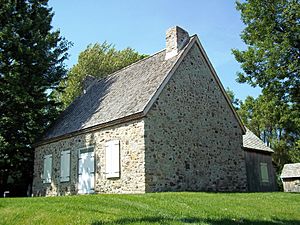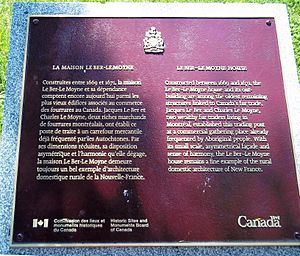LeBer-LeMoyne House facts for kids
The Le Ber-Le Moyne House (also known as Maison Le Ber-Le Moyne in French) is a very old building in Montreal, Quebec, Canada. It was built a long time ago, between 1669 and 1671, making it the oldest complete building in Montreal.
This historic house is located in an area called Lachine. It sits right next to the Saint Lawrence River, near the Lachine Rapids and Lake Saint-Louis. Because of its important history, the Le Ber-Le Moyne House has been recognized as a National Historic Site of Canada since 2002. Its land and the old objects found there are also protected as heritage sites by the government of Quebec.
Contents
A Busy Fur Trading Post (1669–1687)
The Le Ber-Le Moyne House was first built on land that used to belong to a famous French explorer named René-Robert Cavelier de La Salle. In 1667, two very rich merchants from Montreal, Jacques Le Ber and Charles Le Moyne, bought the land. They wanted to build Lachine's very first fur trading post there.
The trading post was built between 1669 and 1671. It helped Jacques Le Ber and Charles Le Moyne, who were brothers-in-law, control the main water routes on Lake Saint-Louis. This control was important for the fur trade, which was a big business back then. Records show that the merchants stopped using the building for trade sometime between 1680 and 1685. Today, the Le Ber-Le Moyne House is the only building left that is connected to Charles Le Moyne's work.
From Trading Post to Farmhouse (1687–1844)
After Charles Le Moyne passed away in 1685, his wife, Catherine Primot, sold the old fur trading post in 1687. A family named dit Lalande bought it. However, they did not stay in Lachine for long. In 1689, they had to leave their home because of a terrible event called the Massacre of Lachine.
In 1695, Marguerite Chorel, who was married to Guillaume de Lorimier, bought the house and the land around it. The couple moved into their new home in 1698. Marguerite became a widow in 1709. She continued to live on the land with her children, farming and living in the Le Ber-Le Moyne House until she passed away in 1736. Her daughter and son then inherited the house and its farmland.
Later, in 1765, an Irish inn owner named Hugh Heney bought the farm. Three years later, Heney hired Jean-Baptiste Crête to update the house. Heney himself never lived in the house. Instead, he rented it out to others who farmed the land.
From Farmhouse to Grand Home (1844–1946)
In the 1840s, the Lachine Canal was made wider. This meant that a lot of the farmland around the house was lost. In 1844, a retired colonel named Edward P. Wilgress bought the property. We can see how the house changed over the years by looking at old artworks. For example, there's a painting by Frances A. Hopkin called "Wilgress House and Garden, Lachine" from 1858-1860, and another by J.E. Taylor called "The Cottage. Lachine" from 1869.
In 1901, a merchant named William Curie bought the Le Ber-Le Moyne House. It then became a summer home for the Curie family.
From Grand Home to Museum (1946–Present)
In the 1940s, the mayor of Lachine, Anatole Carignan, understood how important the Le Ber-Le Moyne House was to history. He believed the city should buy it for everyone to enjoy. So, when the house was put up for sale in 1946, the City of Lachine bought it for $25,000. Mayor Carignan decided to turn the old house into a history museum. The Manoir Lachine, as it was called, officially opened to the public on June 24, 1948.
In the early 1950s, a fish hatchery was set up at the museum. It had ponds and aquariums for raising fish. This hatchery was created by Quebec's Ministry of Hunting and Fishing. Even though the fish hatchery made the museum very popular, it closed in 1962.
The museum changed a lot in the early 1980s. The Le Ber-Le Moyne House was carefully restored. Many parts that had been added over the years, like big additions from the 1950s, a porch, and dormer windows, were removed. The goal was to show the original stone walls and wooden beams. This huge project aimed to bring the house back to its 17th-century look.
Between 1998-2000 and 2009-2010, a company called Archéotec did archaeological digs inside and around the house. They found about 32,000 pieces and objects! These items help us understand the different times people lived on the site. For example, pieces of pottery, beads, and tools from 2,000 to 2,500 years ago show that Native Americans lived there long ago.
For a long time, people thought the trading post built by Le Ber and Le Moyne had been burned down during the 1689 Massacre and then rebuilt later. However, the archaeological digs by Archéotec proved this theory wrong. Archaeologists found no signs of a fire. They also found nothing to suggest the house was rebuilt or repaired by the Chorel family. Archéotec believes that the large number of trading goods found confirms the house was indeed built by Le Moyne and Le Ber.
Today, the Le Ber-Le Moyne House is part of the Musée de Lachine complex. This museum includes the historic Le Ber-Le Moyne site, a special collection of archaeological finds, old buildings from the 1600s, and a sculpture garden. The sculpture garden is called the Musée plein air de Lachine and is one of the biggest in Canada. It features artworks by many artists, including Bill Vazan, Ulysse Comtois, Marcel Barbeau, Michel Goulet, and Linda Covit. Besides its permanent display of historical and archaeological objects, the Musée de Lachine also hosts a new art exhibition each year, featuring works from its own collection.
The museum is about 6 kilometers (4 miles) from the Angrignon Metro station. You can get there by taking the 110 and 195 buses, which are run by the Société de transport de Montréal. The bus ride takes about 40 minutes.
Architecture
The Le Ber-Le Moyne House is a great example of French Colonial architecture. This style often includes features like cedar shingles on the roof and a lack of dormer windows.
See also
 In Spanish: Museo de Lachine para niños
In Spanish: Museo de Lachine para niños



